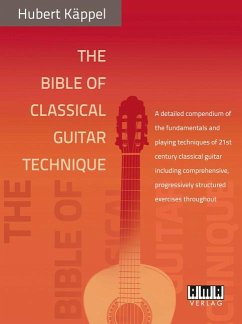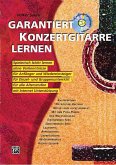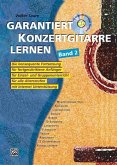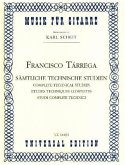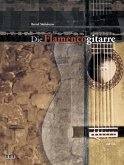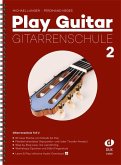Hubert Käppel
The Bible of Classical Guitar Technique
A detailed compendium of the fundamentals and playing techniques of 21st century classical guitar including comprehensive, progressively structured exercises throughout
Hubert Käppel
The Bible of Classical Guitar Technique
A detailed compendium of the fundamentals and playing techniques of 21st century classical guitar including comprehensive, progressively structured exercises throughout
- Broschiertes Buch
- Merkliste
- Auf die Merkliste
- Bewerten Bewerten
- Teilen
- Produkt teilen
- Produkterinnerung
- Produkterinnerung
Detailliertes Kompendium zu den Grundlagen und Spieltechniken des 21. Jahrhunderts mit umfassendem, progressiv aufbauendem Übungsteil
Andere Kunden interessierten sich auch für
![Die Technik der modernen Konzertgitarre Die Technik der modernen Konzertgitarre]() Hubert KäppelDie Technik der modernen Konzertgitarre32,90 €
Hubert KäppelDie Technik der modernen Konzertgitarre32,90 €![Garantiert Konzertgitarre lernen Garantiert Konzertgitarre lernen]() Volker SaureGarantiert Konzertgitarre lernen23,95 €
Volker SaureGarantiert Konzertgitarre lernen23,95 €![Garantiert Konzertgitarre lernen 2 Garantiert Konzertgitarre lernen 2]() Volker SaureGarantiert Konzertgitarre lernen 223,95 €
Volker SaureGarantiert Konzertgitarre lernen 223,95 €![The Complete Studies The Complete Studies]() The Complete Studies29,00 €
The Complete Studies29,00 €![Sämtliche technische Studien Sämtliche technische Studien]() Sämtliche technische StudienSämtliche technische Studien22,50 €
Sämtliche technische StudienSämtliche technische Studien22,50 €![Die Flamencogitarre Die Flamencogitarre]() Bernd SteinmannDie Flamencogitarre29,90 €
Bernd SteinmannDie Flamencogitarre29,90 €![Play Guitar Gitarrenschule 2 Play Guitar Gitarrenschule 2]() Michael LangerPlay Guitar Gitarrenschule 221,95 €
Michael LangerPlay Guitar Gitarrenschule 221,95 €-
-
-
Detailliertes Kompendium zu den Grundlagen und Spieltechniken des 21. Jahrhunderts mit umfassendem, progressiv aufbauendem Übungsteil
Produktdetails
- Produktdetails
- Verlag: AMA-Verlag
- Artikelnr. des Verlages: 610425E
- Seitenzahl: 244
- Erscheinungstermin: 1. April 2016
- Englisch
- Abmessung: 304mm x 228mm x 20mm
- Gewicht: 998g
- ISBN-13: 9783899221916
- ISBN-10: 3899221915
- Artikelnr.: 44785993
- Herstellerkennzeichnung
- Ama Verlag
- Tiergartenstraße 14
- 50321 Brühl
- mail@ama-verlag.de
- 02232 96930
- Verlag: AMA-Verlag
- Artikelnr. des Verlages: 610425E
- Seitenzahl: 244
- Erscheinungstermin: 1. April 2016
- Englisch
- Abmessung: 304mm x 228mm x 20mm
- Gewicht: 998g
- ISBN-13: 9783899221916
- ISBN-10: 3899221915
- Artikelnr.: 44785993
- Herstellerkennzeichnung
- Ama Verlag
- Tiergartenstraße 14
- 50321 Brühl
- mail@ama-verlag.de
- 02232 96930
Hubert Käppel gehört zu den wenigen deutschen international etablierten Gitarristen. Durch seine außergewöhnlichen Interpretationen setzte er neue Maßstäbe und ist heute Vorbild einer ganzen Gitarrengeneration. Seit seiner Aufsehen erregenden Einspielung der 6. Klavierpartita von J.S. Bach führen ihn Konzertreisen als Solist, mit Orchester und in Kammermusikbesetzungen durch Europa, Nord- und Südamerika, Afrika und Asien. Als einer der einflussreichsten Gitarrenlehrer unserer Zeit leitet Hubert Käppel an der Musikhochschule Köln und an der "Koblenz International Guitar Academy" Gitarrenklassen, aus denen mehr als 60 erste Preisträger internationaler Wettbewerbe hervorgingen. Darüber hinaus unterrichtet er an renomierten Universitäten und Konservatorien im In- und Ausland sowie bei Musik- und Gitarrenfestivals weltweit. Als Juror ist er bei den bedeutendsten internationalen Wettbewerben unter anderem in Madrid, Wien, Toronto, Belgrad, Helsinki etc. tätig. 2004 wurde der "Koblenz International Guitar Competition Hubert Käppel" nach ihm benannt, einer der größten internationalen Wettbewerbe weltweit. Hubert Käppel ist Herausgeber und Autor zahlreicher Musikpublikationen und CD-Aufnahmen.
Preface; Introductory Words by Aniello Desiderio; Suggestions for Using this Technique Handbook; Part One: Prerequisites and Basics; I. Short Introduction to Systematic Practicing; Prerequisites; Organizing Your Practicing; Practice Objectives; On Practicing Technique; On Sound, Rhythm and Tempo While Practicing; Motivation; Practicing with a Metronome; The Importance of Playing from Memory While Practicing; On the Frequent Repetition of Difficult Passages, Single Measures or Phrases; II. Holding the Instrument; The Four Points of Contact on the Body; The Correct Angle Towards the Body; Alternate Ways to Hold the Guitar; The Fusion of Body and Guitar into a Single Sound Source; III. Left Hand Posture (LH); Four Universal Rules; The Principles of the Four Hand Shapes; Different Positions of the Left Arm-Hand-Finger System, Clarified by the Fourth Hand Shape; The Positioning of the Fingertips; IV. Short Outline of the Movements of the Left Hand (LH); The Shoulder-Arm-Hand System; The Motion of the Arm; Basic Motions of the Fingers; Intonation and Finger Pressure; Left Hand Shift; Stretching and Contracting the Fingers; Ascending and Descending Slurs; Barre; Vibrato; V. Right Hand Posture (RH); Posture; Base Finger Joint Position Relative to the Strings; VI. Tone Production and a Short Outline of the Movements of the Right Hand (RH); Introduction; Nail Shape; Nail Length; Nail Shape of the Playing Finger; Polishing the Nails; Playing Angle of the RH; A System of Springs; Tirando: Sequence of Motions; Apoyando: Sequence of Motions; Sequence of Motions when Alternating Strokes (m-i and a-m-i); Thumb Attack: Sequence of Motions; Tonal Colors and Point of Contact; Playing Chords (Several Notes Simultaneously): Sequence of Motions; Arpeggios: Sequence of Motions; Part Two: Technical Exercises; I. Arpeggios; The Practicing Units 48; Endurance, Evenness and Speed; Arpeggio Practicing Methods; 1. Variable String Assignments of p-i-m-a; 2. Impulse and Reflex Development; 3. Practicing with Fixed Fingers (RH); Chord Progressions and LH Patterns; Arpeggio Practicing Units; A1 The 6 Basic Arpeggios; A2 6 Basic Arpeggios Expanded to 24; A3 Arpeggios with p-m-i, p-m-a, p-i-a; A4 Alternating Various Arpeggio Patterns; A5 12 Basic Arpeggios with Simultaneous Thumb Attacks; A6 12 Basic Arpeggios with Polyrhythms; A7 Arpeggios with p-i, p-m and p-a; A8 Important Two-Part Arpeggios; A9 The 12 Basic Arpeggios on Three Strings; A10 36 Six Note Arpeggios; A11 24 Eight Note Arpeggios; A12 Variations of the 12 Basic Arpeggios on Three Strings; A13 Arpeggios with Thumb Accompaniment; A14 Various Arpeggio Patterns; A15 12 Basic Arpeggios as Quintuplets; A16 Arpeggios with Two to Eight Note Groupings; A17 112 Arpeggios on the 2nd and 3rd Treble Strings; A18 Basic Arpeggios with Difficult String Crossings; A19 Playing Chords with Arpeggios and Repeated Notes; A20 One Finger Arpeggios over Several Strings; A21 Arpeggios with Thumb Accompaniment to Strengthen Your Attack; Intensive Training of Important Arpeggios; A22 Intensive: The Classic Arpeggio Pattern p-i-m; A23 Intensive: The Classic Arpeggio Pattern p-i-m-a; II. Coordination of the Left and Right Hands; Speed and String Crossing Exercises in the Right Hand; Speed Exercises with Repeating Rhythms on a Single String; Speed Exercises; String Crossing Exercises; Synchronization of Your Left and Right Hands - Exercises Using 2 Fingers from Each; Chromatic Triplet Exercises over All Strings; Synchronization Exercises While Changing Strings; Synchronization of 3 Fingers of the LH / 2 and 3 Fingers of the RH; Synchronization of 4 Fingers of the LH / 2 and 3 Fingers of the RH (24 Permutations); Synchronization of 4 Fingers of Both the Left and Right Hands (8 Note Permutation); Intensive Training of the Chromatic Permutations 1 2 3 4 and 4 3 2 1; Various Coordination Exercises; III. Scales in All Keys; Preparatory Studies for Scales and Runs; Scales over Two and Three Octaves in the Circle of Fifths and Fourths; Five Short Exercises for Major and Minor Scales; Applied Practicing Methods for Scales; 1. RH Patterns, 2. Repetitions, 3. Rhythms; 4. Accents, 5. Articulation 6. Dynamics; Examples for Practicing Single Scales and Runs; Scales in Triplets; Scales in Triplets with Three Finger Alternating Patterns a-m-i and p-m-i; Scale Practicing Models in the Circle of Fifths; 1. 24 Scales with Alternating Finger Patterns; 2. 24 Scales with Repetitions; 3. Using a-m-i and p-m-i in Four Note Groups; 4. The Practicing Model of the 12 Basic Arpeggios (Excluding the Thumb); Practicing an Original Run Chosen from the Repertoire; IV. Ascending and Descending Slurs in the Left Hand; Immediately Changing from the Treble to the Bass Strings; Slurs with Two Fingers; Ascending Two Note Slurs; Descending Two Note Slurs; Combining Ascending and Descending Slurs; Two Note Slurs as Triplets; Complex Two Note Slurs as Triplets; Ascending Two Note Slurs While Crossing Strings; Descending Two Note Slurs While Crossing Strings; Two Note Slurs as Triplets While Crossing Strings; Two Note Slur Combinations While Crossing Strings; Two Note Slur Combinations as Triplets While Changing Strings; Slurs with Three Fingers; Group 1 Diatonic - Triplet Slurs; Group 2 Diatonic - Triplet Slurs; Groups 3 and 4 Chromatic - Triplet Slurs; Slurs with Three Fingers Divided into Four Note Groups; Combining Two and Three Note Slur Combinations; Ascending Slurs with Three Fingers While Crossing Strings; Ascending and Descending Slurs with Open Strings; Slurs with Two Fingers and an Open String; Slurs with Three Fingers and an Open String; Ascending and Descending Slurs as an Embellishment; Short and Intensive Slur Exercises; Scales with Slurs; Chromatic Scales with Slurs; Slurs with Fixed Fingers; Slurs with Fixed Fingers / With and Without Open Strings; Two Note Slurs with Triplets and a Second Part; LH Trill Exercises and Embellishments; Slur Exercise Taken from the Guitar Repertoire Tarrega, Variations on Paganini's "Carnival of Venice
; V. Tremolo; General Practicing Methods; Preparatory Exercises with a-m-i; Tremolo Exercises on One String; Tremolo Exercises Coordinated with LH Exercises; Tremolo Exercises on Various Strings; VI. Flamenco Techniques; Rasgueado Technique; Rasgueado with One, Three and Four Fingers; Rasgueado with Thumb and Fingers; Pulgar Technique - The Special Thumb Technique in Flamenco; VII. Supplementary Technical Exercises for the Left Hand; Shift Position Exercises; Preparatory Shift Exercises; Shifts Resulting from Finger Motion; Direct Shift Exercises; Indirect Shift Exercises; Chromatic Scale on a Single String; Left Hand Independence Exercises; Exercises for Leaving the Fingers on the Strings; 12 Independence Exercises on Two Strings; Four Examples for Practicing; Independence Exercises for the Left Hand on Two Strings (Alternating Two Fingers); Rhythmic Variations on Exercise 15 ("Two Against Three
); Strength and Independence Exercises; Barre Exercises; Barre Exercises According to Llobet; Stretching Exercises for the LH 2Es Thirds, Sixths, Octaves and Compound Thirds; VIII. Additional Technical Exercises for the Right Hand; Tirando and Apoyando Exercises; Tirando Arpeggios Alternating with Apoyando on Two Strings; Tirando Arpeggios Alternating with Repeated Notes in Apoyando; Alternating Tirando and Apoyando; Thumb Exercises; Aguado Study; Simultaneous Attaking and Muting with the Thumb; Coste Study op. 38, No. 23; Exercises to Help Avoid Nail Noise; Pizzicato Exercises; Pizzicato Exercise with Thumb and Index Finger; Pizzicato Exercise with Thumb, Index and Middle Fingers (Three Part); Harmonics Exercises; Natural Harmonics; Artificial Harmonics; Alternating Exercises with the Pinky and i-m-a; Alternating Exercises with Fixed RH Fingers; IX. Practicing Playing Fast; Speed and Relaxation; Practicing Playing Fast with the Right Hand; Pure Reflex Development with Double Dotted Rhythms; Achieving Speed by Playing with the Outside of the Nail; LH Fingers "Sloppily
Placed on Purpose (Without Pressure); Taregga Exercise No. 7; X. Exercises for Perfecting Musical Expression; Vibrato Technique; Sequence of Motions for Vibrato in the Left Hand; Rhythmic Vibrato Exercises; Exercises for Developing the Flexibility of Hand and Fingers; Vibrato Exercises with Two or More Fingers; Vibrato Exercises with Barre; Exercises for Practicing Dynamics; Developing a Broader Dynamic Range; Exercises for Fine Tuning Dynamics; Carcassi Etude op. 60, No. 2 in A Minor; J.S. Bach: Four Part Chorale "Wer weiß, wie nahe mir mein Ende
; Anton Diabelli: Sonata in C Major, Andante sostenuto, 14 Bars; Exercises at Different Dynamic Levels in Two-Part Harmony; The Arpeggiated Chord (Rolled) in a Polyphonic Chord; The Elastic Wrist Attack in Dolce Cantabile Playing; Part Three: Important Topics; I. Fingering Technique; Fingering and Interpretation; Left Hand Fingerings; 1. Tension and Release; 2. Incorporating Harmonic Reasoning when Developing LH Fingerings; 3. How to Use an Open String; 4. The Open String in Scales; 5. Analogous Fingerings; 6. Jumping with One Finger; 7. Special Issues with Fingerings Including Slurs; 8. Shifting by Contracting 1 and 4; Right Hand Fingerings; 1. Basic Fingering Rules for the Fingers of the Right Hand when Crossing Strings; 2. Special Issues Regarding RH Fingerings on the Bass Strings; 3. The Patterns p-m-i, a-m-i and p-a-m-i; 4. Arpeggio Patterns Applied to Scales; 5. Repeated Notes with a Single RH Finger; 6. Combining Different RH Arpeggio Patterns; 7. Using a-i on Neighboring Strings; 8. Special Issues when Using RH Fingerings in a Musical Context; II. Tuning the Guitar; Simple Tuning by Comparing Neighboring Strings; Tuning Using Harmonics and Octaves as an Aid; III. Playing from Memory - Memory and Mental Training; Playing from Memory; Memory Training; Associating Different Areas of Memory; Different Memory Training Methods; Mental Training; IV. Stage Fright and Fear of Performing; V. Technical Practice Guides for Daily Practicing; Short Technical Practice Guide - about 45 Minutes; Compact Technical Practice Guide - about 90 Minutes; Intensive Technical Practice Guide - about 3 Hours; TIP Directory; Bibliography
; V. Tremolo; General Practicing Methods; Preparatory Exercises with a-m-i; Tremolo Exercises on One String; Tremolo Exercises Coordinated with LH Exercises; Tremolo Exercises on Various Strings; VI. Flamenco Techniques; Rasgueado Technique; Rasgueado with One, Three and Four Fingers; Rasgueado with Thumb and Fingers; Pulgar Technique - The Special Thumb Technique in Flamenco; VII. Supplementary Technical Exercises for the Left Hand; Shift Position Exercises; Preparatory Shift Exercises; Shifts Resulting from Finger Motion; Direct Shift Exercises; Indirect Shift Exercises; Chromatic Scale on a Single String; Left Hand Independence Exercises; Exercises for Leaving the Fingers on the Strings; 12 Independence Exercises on Two Strings; Four Examples for Practicing; Independence Exercises for the Left Hand on Two Strings (Alternating Two Fingers); Rhythmic Variations on Exercise 15 ("Two Against Three
); Strength and Independence Exercises; Barre Exercises; Barre Exercises According to Llobet; Stretching Exercises for the LH 2Es Thirds, Sixths, Octaves and Compound Thirds; VIII. Additional Technical Exercises for the Right Hand; Tirando and Apoyando Exercises; Tirando Arpeggios Alternating with Apoyando on Two Strings; Tirando Arpeggios Alternating with Repeated Notes in Apoyando; Alternating Tirando and Apoyando; Thumb Exercises; Aguado Study; Simultaneous Attaking and Muting with the Thumb; Coste Study op. 38, No. 23; Exercises to Help Avoid Nail Noise; Pizzicato Exercises; Pizzicato Exercise with Thumb and Index Finger; Pizzicato Exercise with Thumb, Index and Middle Fingers (Three Part); Harmonics Exercises; Natural Harmonics; Artificial Harmonics; Alternating Exercises with the Pinky and i-m-a; Alternating Exercises with Fixed RH Fingers; IX. Practicing Playing Fast; Speed and Relaxation; Practicing Playing Fast with the Right Hand; Pure Reflex Development with Double Dotted Rhythms; Achieving Speed by Playing with the Outside of the Nail; LH Fingers "Sloppily
Placed on Purpose (Without Pressure); Taregga Exercise No. 7; X. Exercises for Perfecting Musical Expression; Vibrato Technique; Sequence of Motions for Vibrato in the Left Hand; Rhythmic Vibrato Exercises; Exercises for Developing the Flexibility of Hand and Fingers; Vibrato Exercises with Two or More Fingers; Vibrato Exercises with Barre; Exercises for Practicing Dynamics; Developing a Broader Dynamic Range; Exercises for Fine Tuning Dynamics; Carcassi Etude op. 60, No. 2 in A Minor; J.S. Bach: Four Part Chorale "Wer weiß, wie nahe mir mein Ende
; Anton Diabelli: Sonata in C Major, Andante sostenuto, 14 Bars; Exercises at Different Dynamic Levels in Two-Part Harmony; The Arpeggiated Chord (Rolled) in a Polyphonic Chord; The Elastic Wrist Attack in Dolce Cantabile Playing; Part Three: Important Topics; I. Fingering Technique; Fingering and Interpretation; Left Hand Fingerings; 1. Tension and Release; 2. Incorporating Harmonic Reasoning when Developing LH Fingerings; 3. How to Use an Open String; 4. The Open String in Scales; 5. Analogous Fingerings; 6. Jumping with One Finger; 7. Special Issues with Fingerings Including Slurs; 8. Shifting by Contracting 1 and 4; Right Hand Fingerings; 1. Basic Fingering Rules for the Fingers of the Right Hand when Crossing Strings; 2. Special Issues Regarding RH Fingerings on the Bass Strings; 3. The Patterns p-m-i, a-m-i and p-a-m-i; 4. Arpeggio Patterns Applied to Scales; 5. Repeated Notes with a Single RH Finger; 6. Combining Different RH Arpeggio Patterns; 7. Using a-i on Neighboring Strings; 8. Special Issues when Using RH Fingerings in a Musical Context; II. Tuning the Guitar; Simple Tuning by Comparing Neighboring Strings; Tuning Using Harmonics and Octaves as an Aid; III. Playing from Memory - Memory and Mental Training; Playing from Memory; Memory Training; Associating Different Areas of Memory; Different Memory Training Methods; Mental Training; IV. Stage Fright and Fear of Performing; V. Technical Practice Guides for Daily Practicing; Short Technical Practice Guide - about 45 Minutes; Compact Technical Practice Guide - about 90 Minutes; Intensive Technical Practice Guide - about 3 Hours; TIP Directory; Bibliography
Preface; Introductory Words by Aniello Desiderio; Suggestions for Using this Technique Handbook; Part One: Prerequisites and Basics; I. Short Introduction to Systematic Practicing; Prerequisites; Organizing Your Practicing; Practice Objectives; On Practicing Technique; On Sound, Rhythm and Tempo While Practicing; Motivation; Practicing with a Metronome; The Importance of Playing from Memory While Practicing; On the Frequent Repetition of Difficult Passages, Single Measures or Phrases; II. Holding the Instrument; The Four Points of Contact on the Body; The Correct Angle Towards the Body; Alternate Ways to Hold the Guitar; The Fusion of Body and Guitar into a Single Sound Source; III. Left Hand Posture (LH); Four Universal Rules; The Principles of the Four Hand Shapes; Different Positions of the Left Arm-Hand-Finger System, Clarified by the Fourth Hand Shape; The Positioning of the Fingertips; IV. Short Outline of the Movements of the Left Hand (LH); The Shoulder-Arm-Hand System; The Motion of the Arm; Basic Motions of the Fingers; Intonation and Finger Pressure; Left Hand Shift; Stretching and Contracting the Fingers; Ascending and Descending Slurs; Barre; Vibrato; V. Right Hand Posture (RH); Posture; Base Finger Joint Position Relative to the Strings; VI. Tone Production and a Short Outline of the Movements of the Right Hand (RH); Introduction; Nail Shape; Nail Length; Nail Shape of the Playing Finger; Polishing the Nails; Playing Angle of the RH; A System of Springs; Tirando: Sequence of Motions; Apoyando: Sequence of Motions; Sequence of Motions when Alternating Strokes (m-i and a-m-i); Thumb Attack: Sequence of Motions; Tonal Colors and Point of Contact; Playing Chords (Several Notes Simultaneously): Sequence of Motions; Arpeggios: Sequence of Motions; Part Two: Technical Exercises; I. Arpeggios; The Practicing Units 48; Endurance, Evenness and Speed; Arpeggio Practicing Methods; 1. Variable String Assignments of p-i-m-a; 2. Impulse and Reflex Development; 3. Practicing with Fixed Fingers (RH); Chord Progressions and LH Patterns; Arpeggio Practicing Units; A1 The 6 Basic Arpeggios; A2 6 Basic Arpeggios Expanded to 24; A3 Arpeggios with p-m-i, p-m-a, p-i-a; A4 Alternating Various Arpeggio Patterns; A5 12 Basic Arpeggios with Simultaneous Thumb Attacks; A6 12 Basic Arpeggios with Polyrhythms; A7 Arpeggios with p-i, p-m and p-a; A8 Important Two-Part Arpeggios; A9 The 12 Basic Arpeggios on Three Strings; A10 36 Six Note Arpeggios; A11 24 Eight Note Arpeggios; A12 Variations of the 12 Basic Arpeggios on Three Strings; A13 Arpeggios with Thumb Accompaniment; A14 Various Arpeggio Patterns; A15 12 Basic Arpeggios as Quintuplets; A16 Arpeggios with Two to Eight Note Groupings; A17 112 Arpeggios on the 2nd and 3rd Treble Strings; A18 Basic Arpeggios with Difficult String Crossings; A19 Playing Chords with Arpeggios and Repeated Notes; A20 One Finger Arpeggios over Several Strings; A21 Arpeggios with Thumb Accompaniment to Strengthen Your Attack; Intensive Training of Important Arpeggios; A22 Intensive: The Classic Arpeggio Pattern p-i-m; A23 Intensive: The Classic Arpeggio Pattern p-i-m-a; II. Coordination of the Left and Right Hands; Speed and String Crossing Exercises in the Right Hand; Speed Exercises with Repeating Rhythms on a Single String; Speed Exercises; String Crossing Exercises; Synchronization of Your Left and Right Hands - Exercises Using 2 Fingers from Each; Chromatic Triplet Exercises over All Strings; Synchronization Exercises While Changing Strings; Synchronization of 3 Fingers of the LH / 2 and 3 Fingers of the RH; Synchronization of 4 Fingers of the LH / 2 and 3 Fingers of the RH (24 Permutations); Synchronization of 4 Fingers of Both the Left and Right Hands (8 Note Permutation); Intensive Training of the Chromatic Permutations 1 2 3 4 and 4 3 2 1; Various Coordination Exercises; III. Scales in All Keys; Preparatory Studies for Scales and Runs; Scales over Two and Three Octaves in the Circle of Fifths and Fourths; Five Short Exercises for Major and Minor Scales; Applied Practicing Methods for Scales; 1. RH Patterns, 2. Repetitions, 3. Rhythms; 4. Accents, 5. Articulation 6. Dynamics; Examples for Practicing Single Scales and Runs; Scales in Triplets; Scales in Triplets with Three Finger Alternating Patterns a-m-i and p-m-i; Scale Practicing Models in the Circle of Fifths; 1. 24 Scales with Alternating Finger Patterns; 2. 24 Scales with Repetitions; 3. Using a-m-i and p-m-i in Four Note Groups; 4. The Practicing Model of the 12 Basic Arpeggios (Excluding the Thumb); Practicing an Original Run Chosen from the Repertoire; IV. Ascending and Descending Slurs in the Left Hand; Immediately Changing from the Treble to the Bass Strings; Slurs with Two Fingers; Ascending Two Note Slurs; Descending Two Note Slurs; Combining Ascending and Descending Slurs; Two Note Slurs as Triplets; Complex Two Note Slurs as Triplets; Ascending Two Note Slurs While Crossing Strings; Descending Two Note Slurs While Crossing Strings; Two Note Slurs as Triplets While Crossing Strings; Two Note Slur Combinations While Crossing Strings; Two Note Slur Combinations as Triplets While Changing Strings; Slurs with Three Fingers; Group 1 Diatonic - Triplet Slurs; Group 2 Diatonic - Triplet Slurs; Groups 3 and 4 Chromatic - Triplet Slurs; Slurs with Three Fingers Divided into Four Note Groups; Combining Two and Three Note Slur Combinations; Ascending Slurs with Three Fingers While Crossing Strings; Ascending and Descending Slurs with Open Strings; Slurs with Two Fingers and an Open String; Slurs with Three Fingers and an Open String; Ascending and Descending Slurs as an Embellishment; Short and Intensive Slur Exercises; Scales with Slurs; Chromatic Scales with Slurs; Slurs with Fixed Fingers; Slurs with Fixed Fingers / With and Without Open Strings; Two Note Slurs with Triplets and a Second Part; LH Trill Exercises and Embellishments; Slur Exercise Taken from the Guitar Repertoire Tarrega, Variations on Paganini's "Carnival of Venice
; V. Tremolo; General Practicing Methods; Preparatory Exercises with a-m-i; Tremolo Exercises on One String; Tremolo Exercises Coordinated with LH Exercises; Tremolo Exercises on Various Strings; VI. Flamenco Techniques; Rasgueado Technique; Rasgueado with One, Three and Four Fingers; Rasgueado with Thumb and Fingers; Pulgar Technique - The Special Thumb Technique in Flamenco; VII. Supplementary Technical Exercises for the Left Hand; Shift Position Exercises; Preparatory Shift Exercises; Shifts Resulting from Finger Motion; Direct Shift Exercises; Indirect Shift Exercises; Chromatic Scale on a Single String; Left Hand Independence Exercises; Exercises for Leaving the Fingers on the Strings; 12 Independence Exercises on Two Strings; Four Examples for Practicing; Independence Exercises for the Left Hand on Two Strings (Alternating Two Fingers); Rhythmic Variations on Exercise 15 ("Two Against Three
); Strength and Independence Exercises; Barre Exercises; Barre Exercises According to Llobet; Stretching Exercises for the LH 2Es Thirds, Sixths, Octaves and Compound Thirds; VIII. Additional Technical Exercises for the Right Hand; Tirando and Apoyando Exercises; Tirando Arpeggios Alternating with Apoyando on Two Strings; Tirando Arpeggios Alternating with Repeated Notes in Apoyando; Alternating Tirando and Apoyando; Thumb Exercises; Aguado Study; Simultaneous Attaking and Muting with the Thumb; Coste Study op. 38, No. 23; Exercises to Help Avoid Nail Noise; Pizzicato Exercises; Pizzicato Exercise with Thumb and Index Finger; Pizzicato Exercise with Thumb, Index and Middle Fingers (Three Part); Harmonics Exercises; Natural Harmonics; Artificial Harmonics; Alternating Exercises with the Pinky and i-m-a; Alternating Exercises with Fixed RH Fingers; IX. Practicing Playing Fast; Speed and Relaxation; Practicing Playing Fast with the Right Hand; Pure Reflex Development with Double Dotted Rhythms; Achieving Speed by Playing with the Outside of the Nail; LH Fingers "Sloppily
Placed on Purpose (Without Pressure); Taregga Exercise No. 7; X. Exercises for Perfecting Musical Expression; Vibrato Technique; Sequence of Motions for Vibrato in the Left Hand; Rhythmic Vibrato Exercises; Exercises for Developing the Flexibility of Hand and Fingers; Vibrato Exercises with Two or More Fingers; Vibrato Exercises with Barre; Exercises for Practicing Dynamics; Developing a Broader Dynamic Range; Exercises for Fine Tuning Dynamics; Carcassi Etude op. 60, No. 2 in A Minor; J.S. Bach: Four Part Chorale "Wer weiß, wie nahe mir mein Ende
; Anton Diabelli: Sonata in C Major, Andante sostenuto, 14 Bars; Exercises at Different Dynamic Levels in Two-Part Harmony; The Arpeggiated Chord (Rolled) in a Polyphonic Chord; The Elastic Wrist Attack in Dolce Cantabile Playing; Part Three: Important Topics; I. Fingering Technique; Fingering and Interpretation; Left Hand Fingerings; 1. Tension and Release; 2. Incorporating Harmonic Reasoning when Developing LH Fingerings; 3. How to Use an Open String; 4. The Open String in Scales; 5. Analogous Fingerings; 6. Jumping with One Finger; 7. Special Issues with Fingerings Including Slurs; 8. Shifting by Contracting 1 and 4; Right Hand Fingerings; 1. Basic Fingering Rules for the Fingers of the Right Hand when Crossing Strings; 2. Special Issues Regarding RH Fingerings on the Bass Strings; 3. The Patterns p-m-i, a-m-i and p-a-m-i; 4. Arpeggio Patterns Applied to Scales; 5. Repeated Notes with a Single RH Finger; 6. Combining Different RH Arpeggio Patterns; 7. Using a-i on Neighboring Strings; 8. Special Issues when Using RH Fingerings in a Musical Context; II. Tuning the Guitar; Simple Tuning by Comparing Neighboring Strings; Tuning Using Harmonics and Octaves as an Aid; III. Playing from Memory - Memory and Mental Training; Playing from Memory; Memory Training; Associating Different Areas of Memory; Different Memory Training Methods; Mental Training; IV. Stage Fright and Fear of Performing; V. Technical Practice Guides for Daily Practicing; Short Technical Practice Guide - about 45 Minutes; Compact Technical Practice Guide - about 90 Minutes; Intensive Technical Practice Guide - about 3 Hours; TIP Directory; Bibliography
; V. Tremolo; General Practicing Methods; Preparatory Exercises with a-m-i; Tremolo Exercises on One String; Tremolo Exercises Coordinated with LH Exercises; Tremolo Exercises on Various Strings; VI. Flamenco Techniques; Rasgueado Technique; Rasgueado with One, Three and Four Fingers; Rasgueado with Thumb and Fingers; Pulgar Technique - The Special Thumb Technique in Flamenco; VII. Supplementary Technical Exercises for the Left Hand; Shift Position Exercises; Preparatory Shift Exercises; Shifts Resulting from Finger Motion; Direct Shift Exercises; Indirect Shift Exercises; Chromatic Scale on a Single String; Left Hand Independence Exercises; Exercises for Leaving the Fingers on the Strings; 12 Independence Exercises on Two Strings; Four Examples for Practicing; Independence Exercises for the Left Hand on Two Strings (Alternating Two Fingers); Rhythmic Variations on Exercise 15 ("Two Against Three
); Strength and Independence Exercises; Barre Exercises; Barre Exercises According to Llobet; Stretching Exercises for the LH 2Es Thirds, Sixths, Octaves and Compound Thirds; VIII. Additional Technical Exercises for the Right Hand; Tirando and Apoyando Exercises; Tirando Arpeggios Alternating with Apoyando on Two Strings; Tirando Arpeggios Alternating with Repeated Notes in Apoyando; Alternating Tirando and Apoyando; Thumb Exercises; Aguado Study; Simultaneous Attaking and Muting with the Thumb; Coste Study op. 38, No. 23; Exercises to Help Avoid Nail Noise; Pizzicato Exercises; Pizzicato Exercise with Thumb and Index Finger; Pizzicato Exercise with Thumb, Index and Middle Fingers (Three Part); Harmonics Exercises; Natural Harmonics; Artificial Harmonics; Alternating Exercises with the Pinky and i-m-a; Alternating Exercises with Fixed RH Fingers; IX. Practicing Playing Fast; Speed and Relaxation; Practicing Playing Fast with the Right Hand; Pure Reflex Development with Double Dotted Rhythms; Achieving Speed by Playing with the Outside of the Nail; LH Fingers "Sloppily
Placed on Purpose (Without Pressure); Taregga Exercise No. 7; X. Exercises for Perfecting Musical Expression; Vibrato Technique; Sequence of Motions for Vibrato in the Left Hand; Rhythmic Vibrato Exercises; Exercises for Developing the Flexibility of Hand and Fingers; Vibrato Exercises with Two or More Fingers; Vibrato Exercises with Barre; Exercises for Practicing Dynamics; Developing a Broader Dynamic Range; Exercises for Fine Tuning Dynamics; Carcassi Etude op. 60, No. 2 in A Minor; J.S. Bach: Four Part Chorale "Wer weiß, wie nahe mir mein Ende
; Anton Diabelli: Sonata in C Major, Andante sostenuto, 14 Bars; Exercises at Different Dynamic Levels in Two-Part Harmony; The Arpeggiated Chord (Rolled) in a Polyphonic Chord; The Elastic Wrist Attack in Dolce Cantabile Playing; Part Three: Important Topics; I. Fingering Technique; Fingering and Interpretation; Left Hand Fingerings; 1. Tension and Release; 2. Incorporating Harmonic Reasoning when Developing LH Fingerings; 3. How to Use an Open String; 4. The Open String in Scales; 5. Analogous Fingerings; 6. Jumping with One Finger; 7. Special Issues with Fingerings Including Slurs; 8. Shifting by Contracting 1 and 4; Right Hand Fingerings; 1. Basic Fingering Rules for the Fingers of the Right Hand when Crossing Strings; 2. Special Issues Regarding RH Fingerings on the Bass Strings; 3. The Patterns p-m-i, a-m-i and p-a-m-i; 4. Arpeggio Patterns Applied to Scales; 5. Repeated Notes with a Single RH Finger; 6. Combining Different RH Arpeggio Patterns; 7. Using a-i on Neighboring Strings; 8. Special Issues when Using RH Fingerings in a Musical Context; II. Tuning the Guitar; Simple Tuning by Comparing Neighboring Strings; Tuning Using Harmonics and Octaves as an Aid; III. Playing from Memory - Memory and Mental Training; Playing from Memory; Memory Training; Associating Different Areas of Memory; Different Memory Training Methods; Mental Training; IV. Stage Fright and Fear of Performing; V. Technical Practice Guides for Daily Practicing; Short Technical Practice Guide - about 45 Minutes; Compact Technical Practice Guide - about 90 Minutes; Intensive Technical Practice Guide - about 3 Hours; TIP Directory; Bibliography

